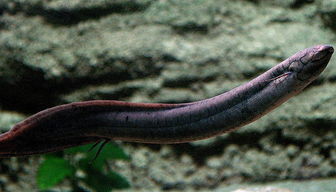South american lungfish
Additional common names of this species include American mud-fish

Original source: : Image:Lepidosiren paradoxa.jpg
The South american lungfish lives in the demersal, freshwater environment.
The South American Lungfish, also known as the Amazonian Lungfish, was described by Fitzinger in 1837. The are found in swampy areas throughout the Amazon, Paraguay and lower Paraná River basins. Status: The species is not listed on the IUCN Red List. More
the South American lungfish develops a pair of feathery appendages that are actually highly modified pelvic fins. It is thought these fins improve gas exchange around the fish's eggs in its nest. The dentition of lungfish is different from that of any other vertebrate group. More
The South American lungfish, Lepidosiren paradoxa, is the single species of lungfish found in swamps and slow-moving waters of the Amazon, Paraguay, and lower Paraná River basins in South America. Notable as an obligate air-breather, it is the sole member of its family Lepidosirenidae. More
The African and South American lungfish can estivate (become dormant) during dry periods or droughts, usually for only a few months but possibly for more than four years. The fish burrow into the mud and secrete a covering of mucus around themselves. More
African and South American lungfish can easily be distinguished by their appearance, but they also share many similar characters. More
African and South American lungfish are capable of surviving seasonal drying out of their habitats by burrowing into mud and estivating throughout the dry season. More
South American lungfish The South American lungfish, Lepidosiren paradoxa, is the single species of lungfish found in swamps and slow-moving waters of the Amazon, Paraguay, and lower Paraná River basins in South America. More
The South American lungfish (Lepidosiren paradoxa) was the first lungfish species to be described (in 1837 by Leopold J. F. J. Fitzinger; 1802–1884). More
Common names
Amerikankeuhkokala in Finnish (suomen kieli)
Amerikanskiy cheshuichatnik in Russian (русский язык)
Anguille tété in Creole, French
Anguille tété in Creoles and Pidgins, French
Bahník americký in Czech (česky)
Karamuru in Czech (česky)
Lepidosiren paradoxa in French (français)
Lepidosiren paradoxa in Latin (latine)
Lepidosirena in Spanish (español)
Loloch in Spanish (español)
Lurchfisch in German (Deutsch)
Pilayi in Oyampi
Pilayi in South American Indian (Other)
Pilayi in Wayana
Pirá-cururú in Spanish (español)
Piracourou-boia in Portuguese (Português)
Piracuru-bóia in Portuguese (Português)
Pirambóia in Portuguese (Português)
piramboia in Spanish (español)
Plazak a. praplaziec in Polish (polski)
south american lungfish in English
Südamerikanischer Lungenfisch in German (Deutsch)
Sydamerikansk lungefisk in Danish (dansk)
Tarrira-boia in Portuguese (Português)
чешуйчатик американский in Russian (русский язык)
南美肺魚 in Mandarin Chinese
南美肺鱼 in Mandarin Chinese

Family : Lepidosirenidae
Genus : Lepidosiren
Species : Lepidosiren paradoxa
Authority : Fitzinger, 1837
